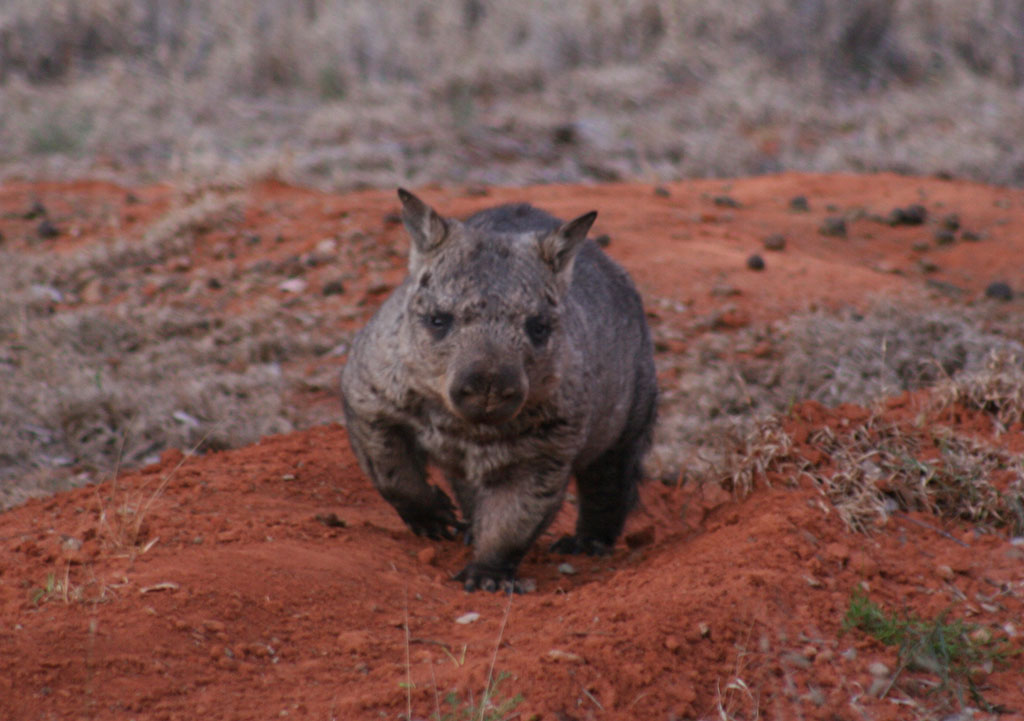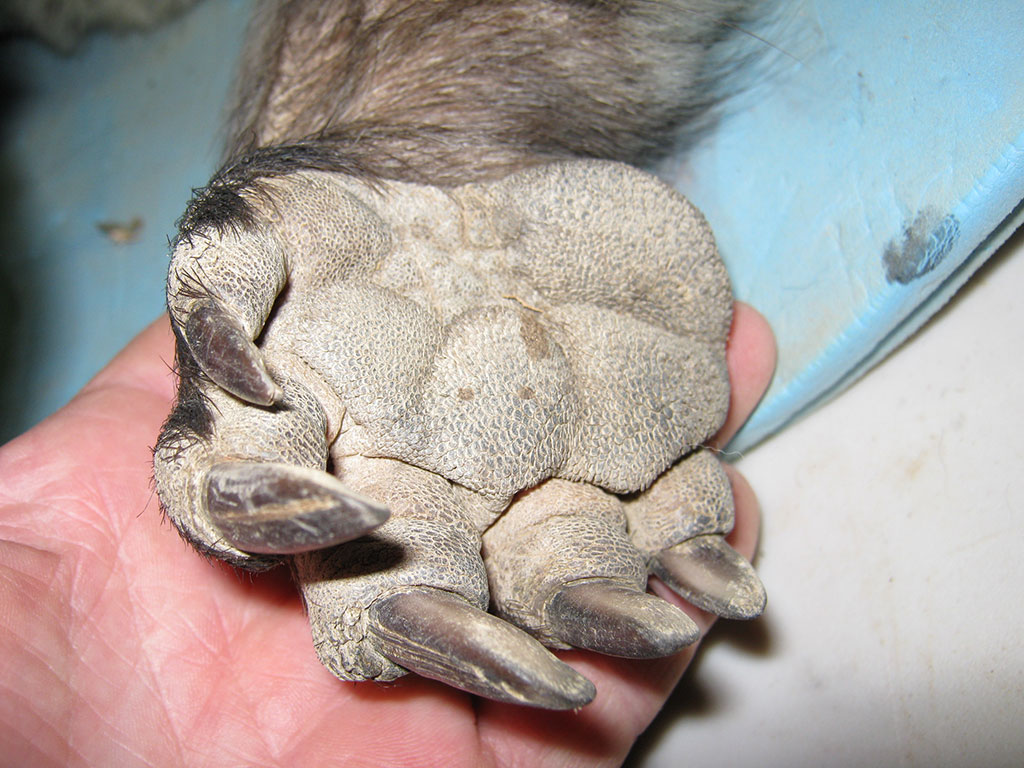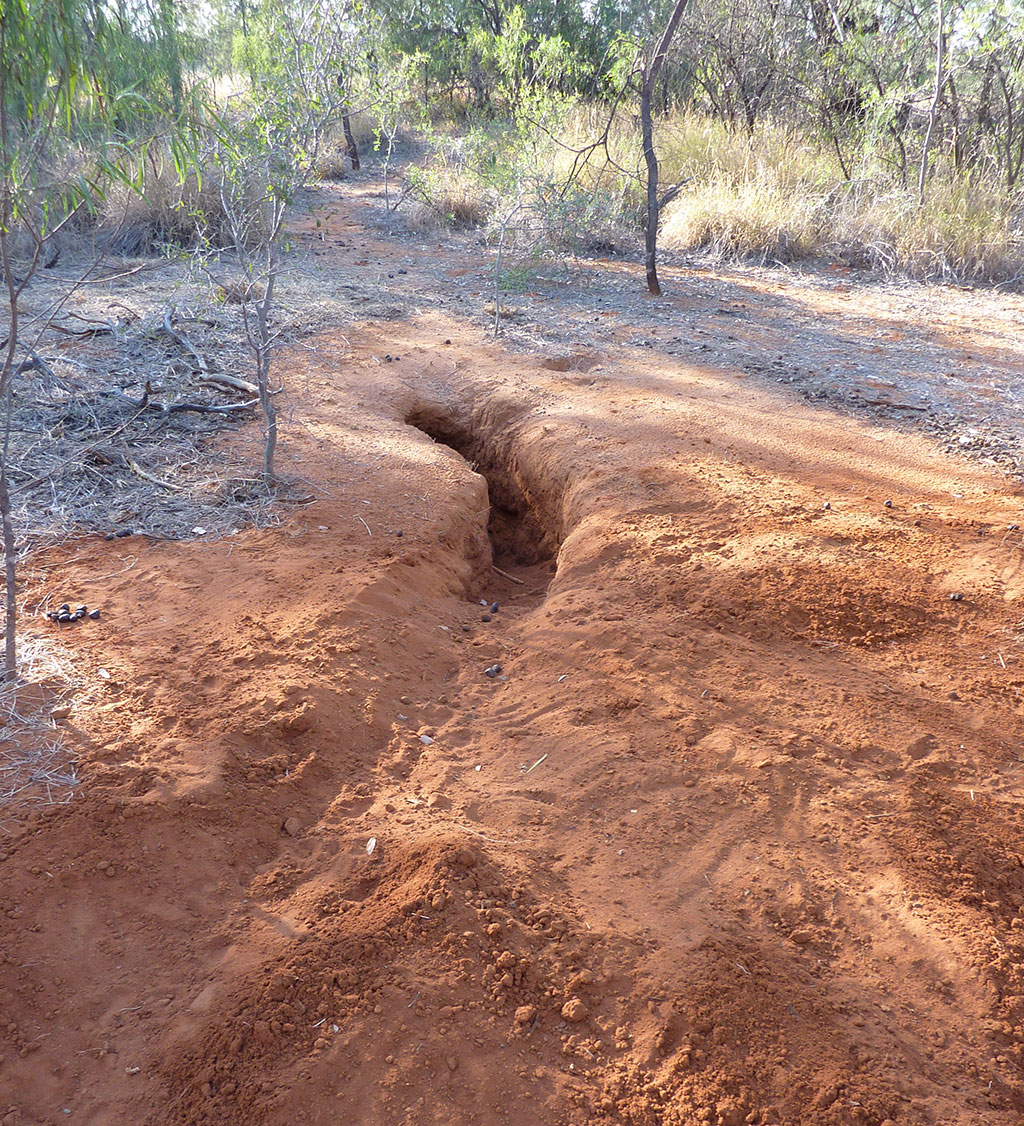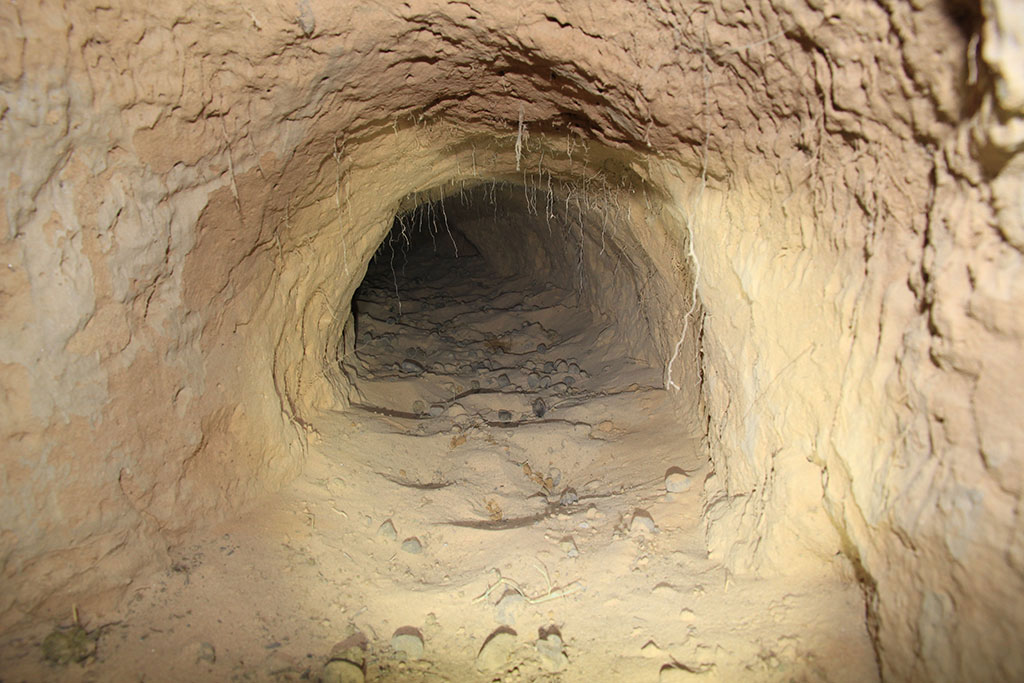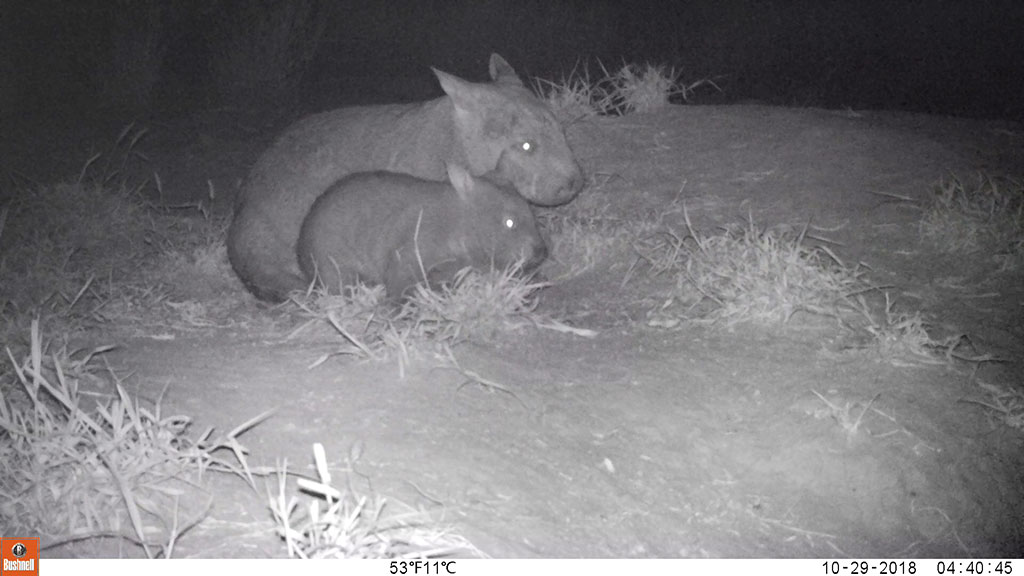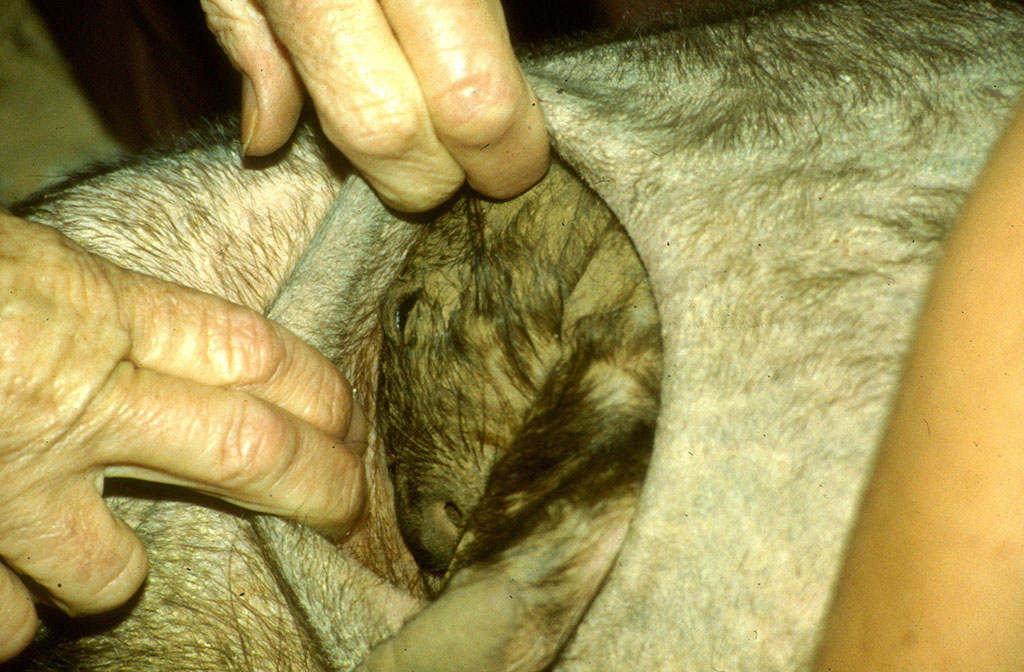About northern hairy-nosed wombats
Northern hairy-nosed wombat Photo: Melissa Mayhew
Common name: Northern hairy-nosed wombat
Scientific name: Lasiorhinus krefftii (Lasio = hairy; rhinus = nose; krefftii = after Gerard Krefft, Director of the Australian Museum from 1864-1874).
Family: Vombatidae (wombats).
The northern hairy-nosed wombat is listed as:
- Critically Endangered in Queensland under the Queensland Nature Conservation Act 1992.
- Critically Endangered nationally under the Commonwealth Environment Protection and Biodiversity Conservation Act 1999.
- Critically Endangered internationally under the International Union for the Conservation of Nature Redlist of Threatened Species, which lists species at a global level.
What is a wombat and where can they be found?
Wombats are a marsupial and the closest living relative to the koala. They are heavily built animals with a broad head and short solid powerful legs. They also have strong claws to dig their burrows, where they spend most of the time.
When wombats walk, their behinds sway from side to side. This feature, along with their large heads and habits, such as curling up to rest on their sides or sitting on their haunches with their forepaws folded in front, make wombats appear slow and clumsy.
However, appearances are deceptive. Wombats can move fast—up to 40 km/h over a short distance.
There are three species of wombat in Australia: the bare-nosed wombat (Vombatus ursinus), the southern hairy-nosed wombat (Lasiorhinus latifrons) and the northern hairy-nosed wombat (Lasiorhinus krefftii).


Bare-nosed wombat
Bare-nosed wombats, also known as common wombats, are found in the coastal and high-country areas in south-east Australia. They have a bare pointed nose, small ears and coarse brown fur. They average about 30kg in weight (22–39kg). Bare-nosed wombats are nocturnal during the summer, but in winter often come out of their burrows during the day to feed and sun themselves.
Southern hairy-nosed wombat
The southern hairy-nosed wombat is the smallest wombat species, with adults averaging about 26kg. It has a broad hairy nose, long ears and soft grey-brown fur. There is often a white patch on the nose and chest. Southern hairy-nosed wombats are the most arid-adapted wombats and, although have reduced in number, are still found scattered across southern Australia.
Northern hairy-nosed wombat
The largest, and rarest, wombat species is the northern hairy-nosed wombat, which averages about 32kg and reaches more than one metre in length. Compared with the bare-nosed wombat, northern hairy-nosed wombats have softer fur, longer and more pointed ears and a broader muzzle fringed with fine whiskers. They are generally nocturnal but will sun themselves on winter mornings and afternoons. Northern hairy-nosed wombats are known to live for at least 28 years.


Detection of northern hairy-nosed wombat burrow use over a 24 period at Richard Underwood Nature Refuge between August 2019 and March 2020.
Fossil records show that the northern hairy-nosed wombat was once widespread, through Victoria, New South Wales and Queensland. However, since European settlement, this species has only been found in three locations—the Deniliquin area in southern New South Wales, the Moonie River area in southern Queensland, and the Epping Forest area in central Queensland. By 1982, the northern hairy-nosed wombats were restricted to a single population at Epping Forest National Park (Scientific).
Epping Forest National Park (Scientific) is located in inland central Queensland. It is 2,750 ha of open eucalypt woodland and brigalow communities and was gazetted in 1971.
A second colony of northern hairy-nosed wombats was established in 2009 at Richard Underwood Nature Refuge at Yarran Downs near St George in southern Queensland. The nature refuge was gazetted in 2008 and protects about 130 hectares of eucalypt woodland on old riverbanks. The first northern hairy-nosed wombats were translocated to the site in July 2009, with additional wombats added in 2010. To promote breeding and maintain genetic diversity, wombats are added to the population periodically.The first breeding occurred in 2011.
Both populations are heavily managed by the Department of Environment, Science and Innovation to ensure the species continues to thrive and expand.
Visit “Conservation of northern hairy-nosed wombats” *link * to learn more about the threats facing northern hairy-nosed wombats in Queensland.
How many northern hairy-nosed wombats are there?
Until 2000, wombat numbers were determined by trapping individuals to estimate population size. Although trapping was a lengthy and disruptive process, it provided useful data on health and reproductive status of the population. Since 2000, a hair census technique has been used to produce wombat population estimates. The hair census technique relies on collecting wombat hair on strips of double-sided sticky tape placed across the entrance to active burrows. Genetic data is extracted from the hair and analysed by a statistician to produce a population estimate.


What are the habitat requirements of northern hairy-nosed wombats?
Northern hairy-nosed wombats require a year-round supply of grass, which is their primary food source, and deep sandy soils to dig burrows. Areas that support sufficient levels of grass are predominantly associated with open eucalypt woodlands.
Not all soils are suitable for northern hairy-nosed wombats to dig their burrows. In Epping Forest National Park (Scientific), they dig their burrows in the deep, sandy soils along ancient dry creek beds. They forage in areas of heavy clay soils adjacent to the sandy soils, but do not dig burrows in the clay soils, which become water-logged in the wet seasons. At Epping Forest National Park (Scientific), burrows are often associated with native bauhina trees, Lysiphyllum hookeri. This tree has a spreading growth form and it roots probably provide stability for the extensive burrows dug by northern hairy-nosed wombats.
What does a northern hairy-nosed wombat burrow look like?
A northern hairy-nosed wombat burrow can be detected in the landscape by a mound of dug-out sand at the entrance, which can be more than one metre high and several metres long. A ‘runway’ passes through the mound and leads to the burrow entrance. Wombats dig the burrow with their forepaws, kicking the loose sand behind them. They then walk backwards out of their burrow to bulldoze the sand clear. A northern hairy-nosed wombat will mark the entrance and mound near its burrow with dung, splashes of urine and scratches.


Researchers at Epping Forest National Park (Scientific) have mapped several northern hairy-nosed wombat burrows. The largest mapped burrow contained more than 90 metres of tunnels and six entrances. Major burrows average 3 to 3.5m in depth with a diameter of less than half a metre, just enough for a wombat to pass.
Temperatures in the burrows are remarkably stable and do not vary more than 5–6°C each day. Even on cold winter nights when temperatures above ground drop below zero, burrow temperature will not drop below about 12°C. Stable burrow temperatures mean wombats can avoid extreme heat and cold conditions by only exiting their burrows when temperatures are favourable.
Compared to above ground, humidity is higher in deep burrows. Breathing the moist air in burrows helps northern hairy-nosed wombats conserve moisture, even during the hot dry summer months.
Social behaviour of northern hairy-nosed wombats
There is limited information on the behaviour of northern hairy-nosed wombats due to their burrowing and nocturnal habits (i.e. they spend a lot of their time underground, and usually only come out at night-time). Northern hairy-nosed wombats are generally solitary animals; however, they live in clusters of burrows that can be used by four to five wombats.
Burrow sharing usually involves only with male and female interaction being restricted to breeding (Johnson 1991). This close association between individuals and overlapping feeding areas indicate some level of social organisation within the species. There was also evidence from Epping Forest National Park (Scientific) that wombats followed the trail or scent of other wombats, indicating they prefer to be in the presence of other wombats.
What do northern hairy-nosed wombats eat?


Northern hairy-nosed wombats are grazing animals, feeding solely on native and introduced grasses. Although their diet is fibrous, tooth wear is not an issue for wombats, as their teeth continue to grow throughout their life. This means even a very old wombat still has a full set of teeth and can grind its food very finely to extract as much nutrients as possible.
Adult northern hairy-nosed wombats generally maintain good body condition year-round, as well as during droughts, due to their cool, humid burrows increasing the ability to conserve energy and water. This lower energetic requirement also means wombats spend relatively little time foraging. They feed, on average, six hours a night in winter and two hours in summer. In comparison, an eastern grey kangaroo needs to feed for about 18 hours a day.
The area northern hairy-nosed wombat’s forage is larger during winter (dry season) than summer (wet season) due to lower food availability. Although males are generally larger than females, foraging areas are similar between males and females—approximately 27 hectares.
Epping Forest National Park (Scientific) and Richard Underwood Nature Refuge are equipped with water stations, which are mainly visited by wombats in the dry seasons; although, not all northern hairy-nosed wombats will use them. Supplementary food has been provided in extreme drought conditions.
What is the reproductive biology of the northern hairy-nosed wombat?
Breeding biology of the northern hairy-nosed wombat is thought to be similar to the southern hairy-nosed wombat, with female northern hairy-nosed wombats likely to become sexually mature at about two and a half years old and males at about three years old.
After a gestation period of 21 days, northern-hairy nosed wombats give birth to a single joey which is kept in the mother’s pouch for eight to nine months. The exact time young wombats spend with their mothers after permanent emergence from the pouch is unknown, but it's likely around one year. At Epping Forest National Park (Scientific), most young emerge from the pouch in summer between November and April, when the availability of green grass is at its highest.
Breeding success is heavily affected by rainfall, with reduced breeding rates recorded at Epping Forest National Park (Scientific) during the drought period in the early 1990s. Periods of higher than average rainfall at Epping Forest National Park (Scientific) have stimulated breeding success, with between 50 and 80% of females breeding in good years.



